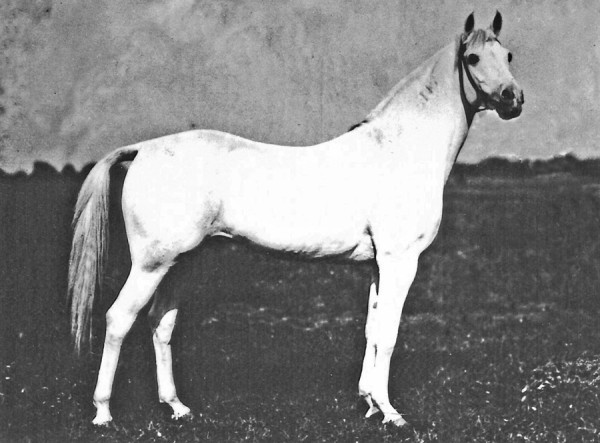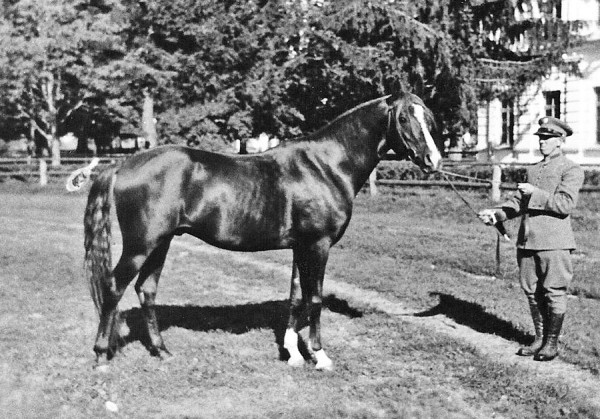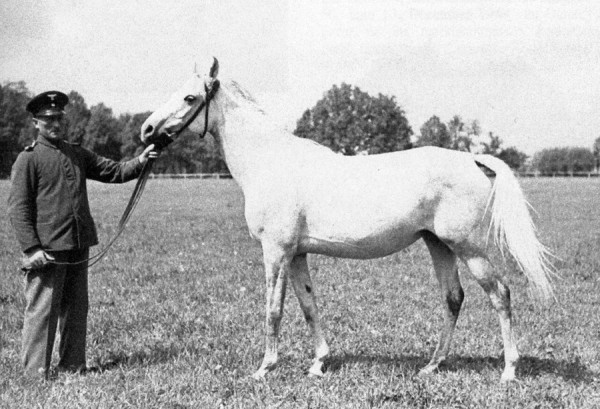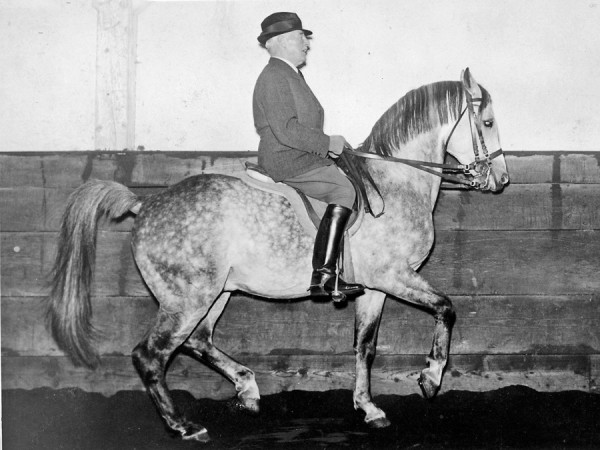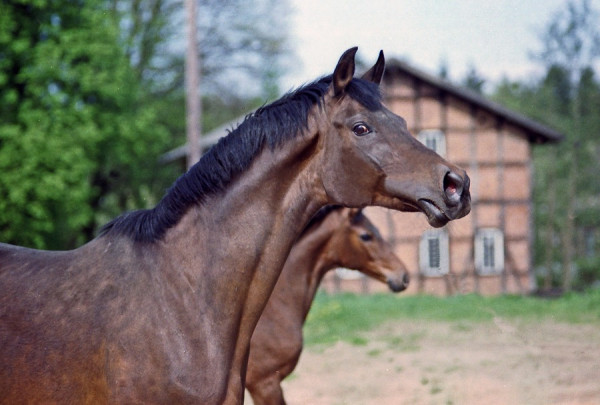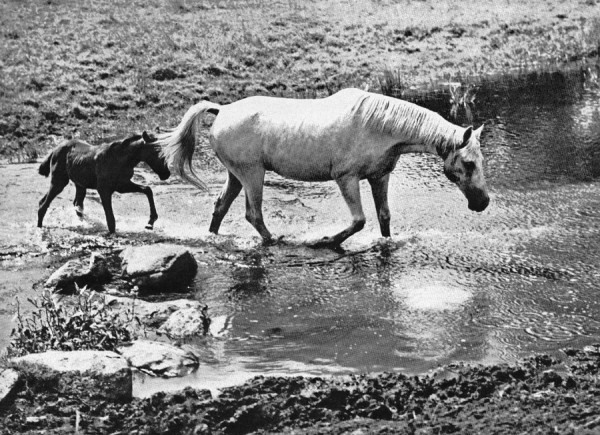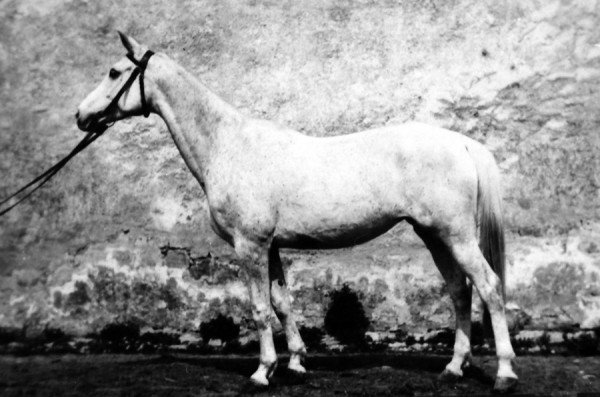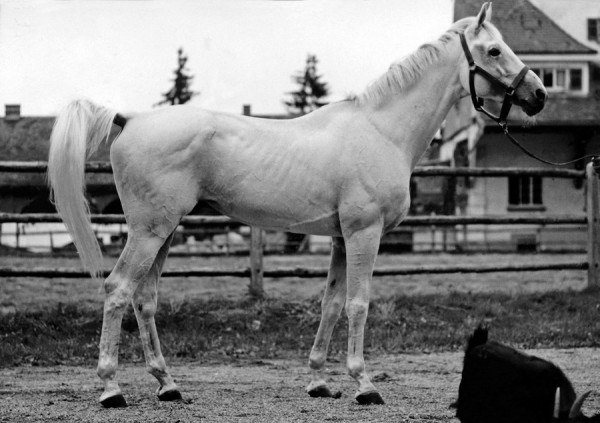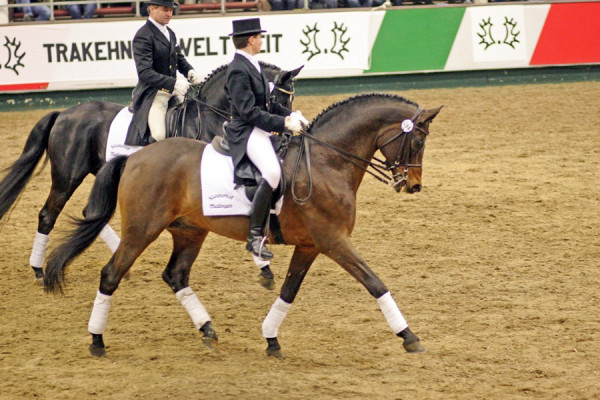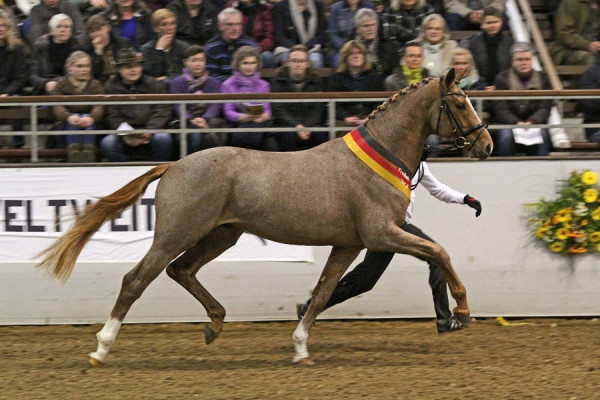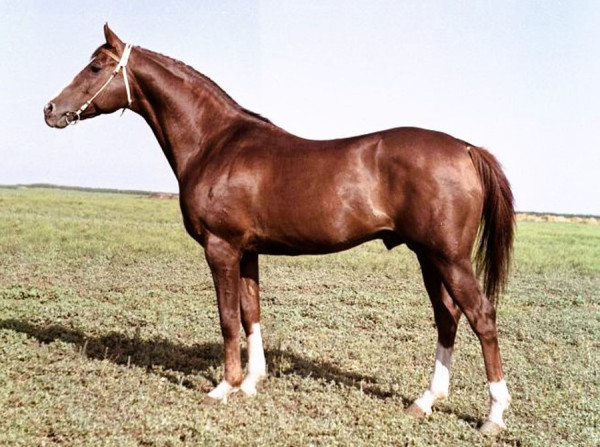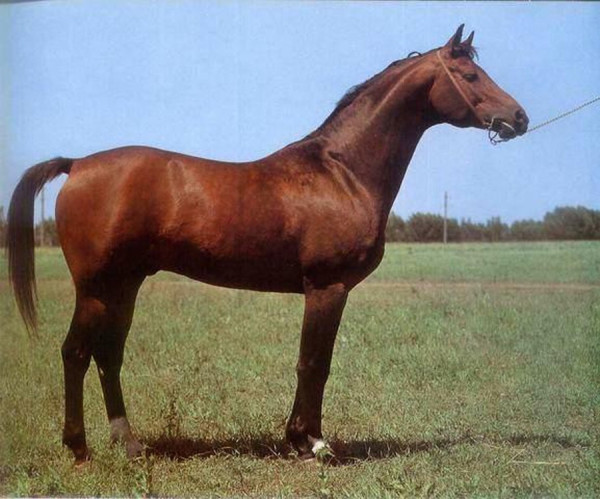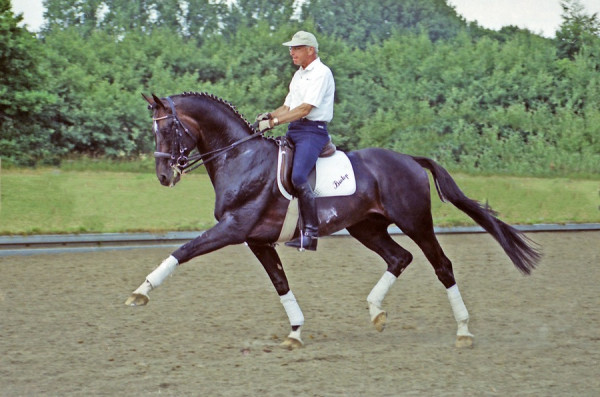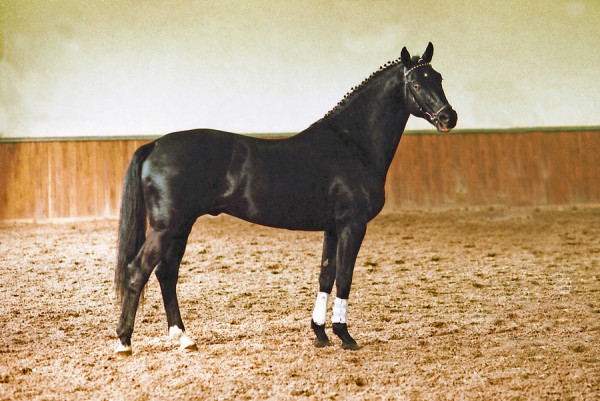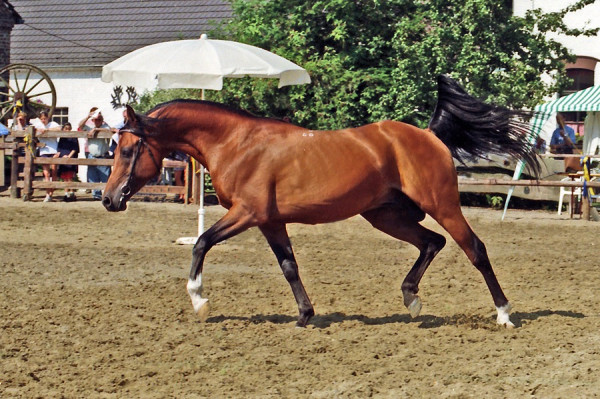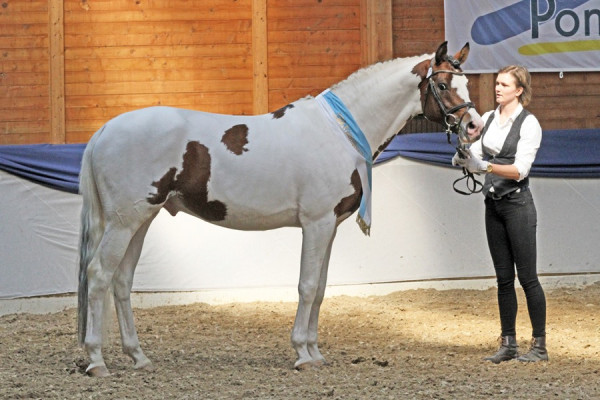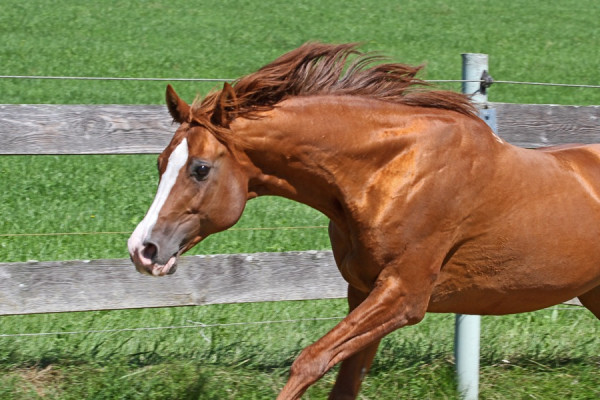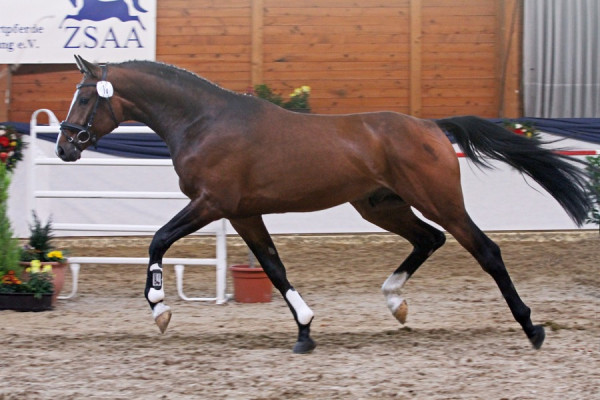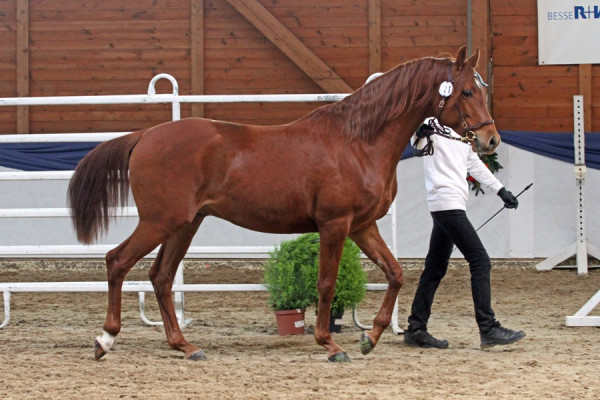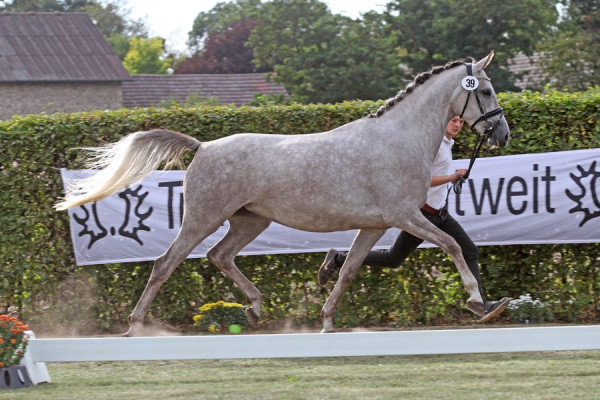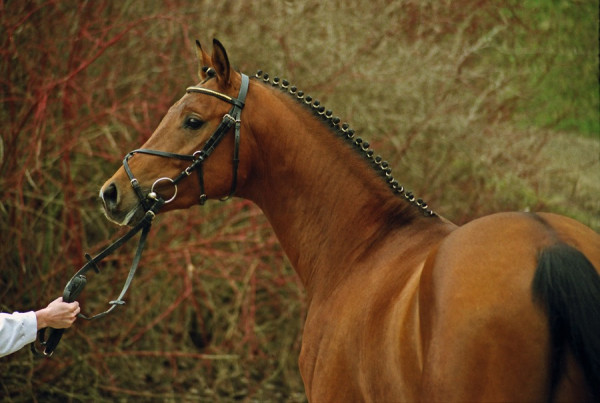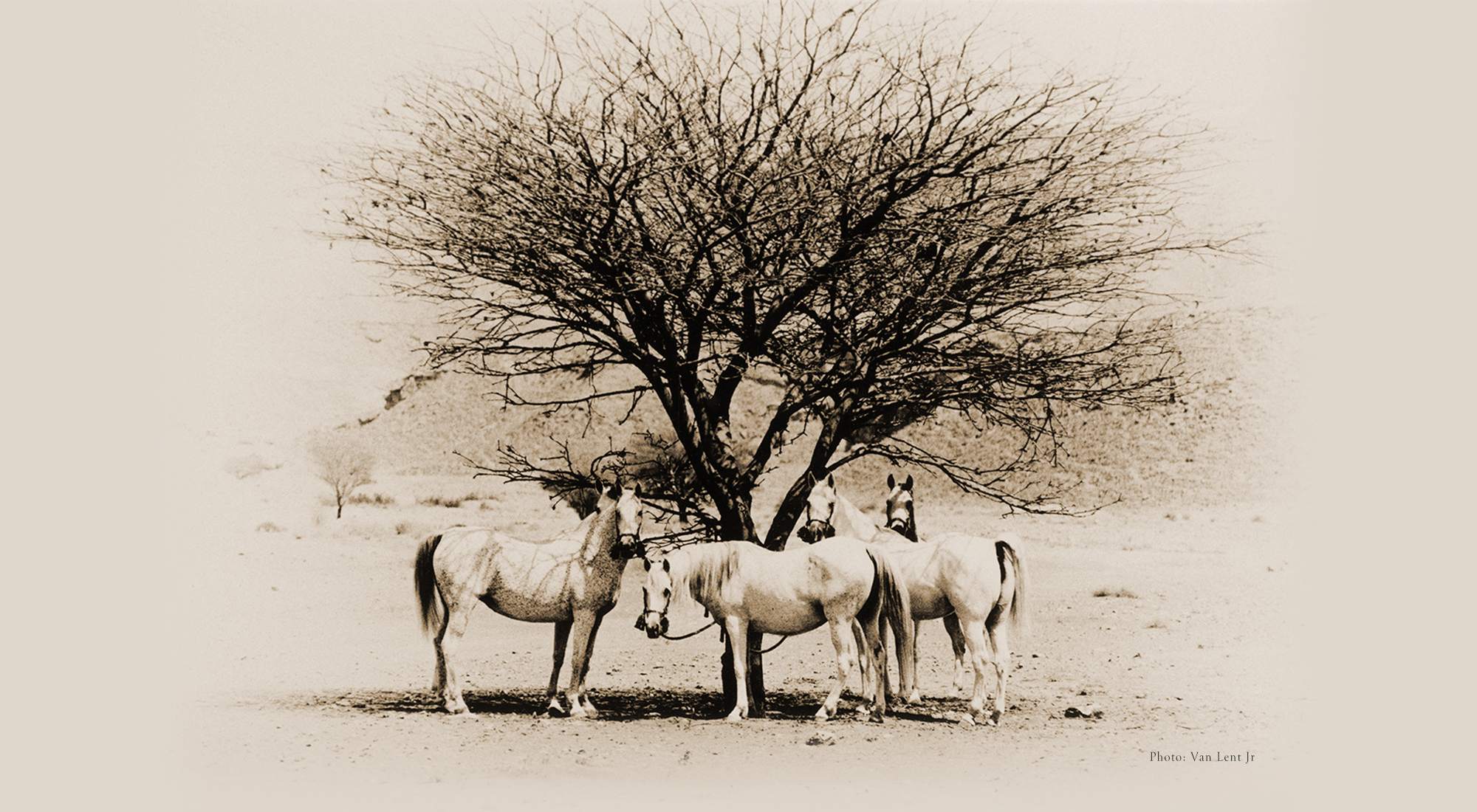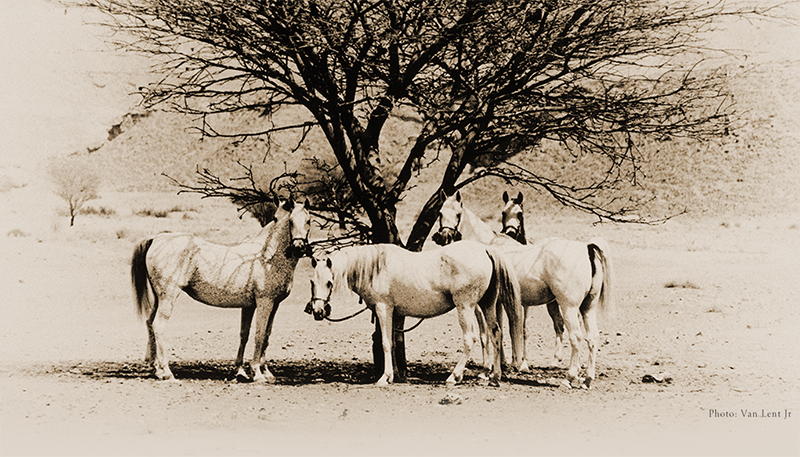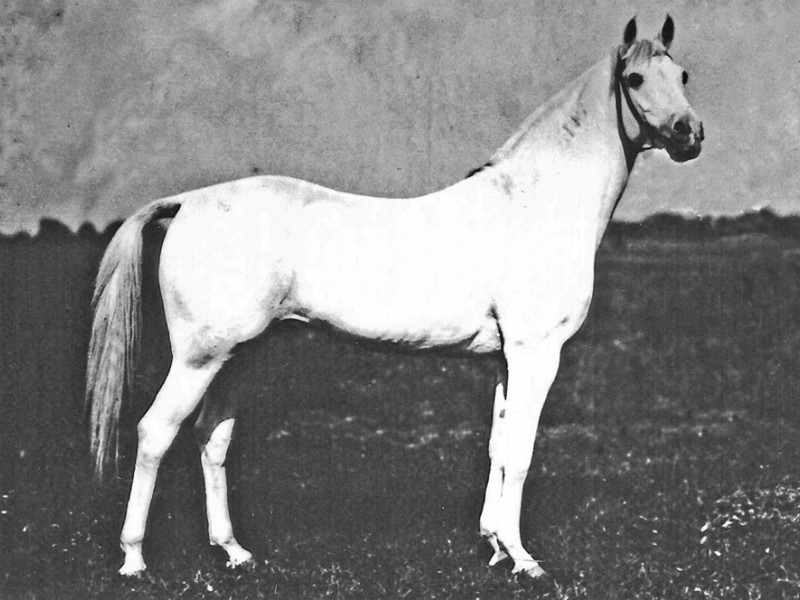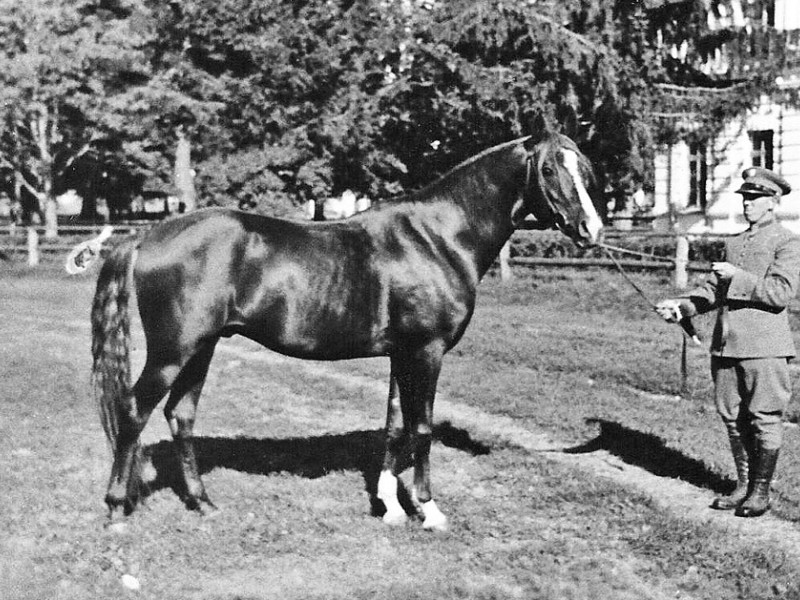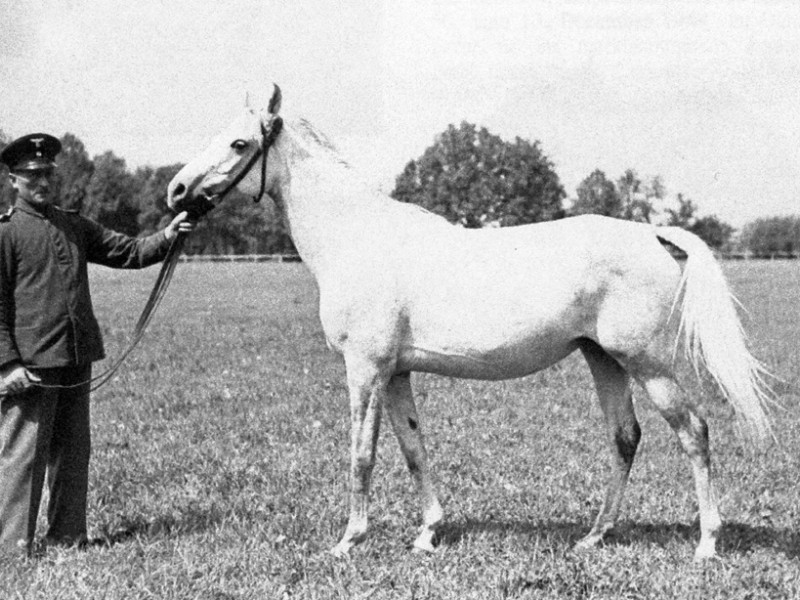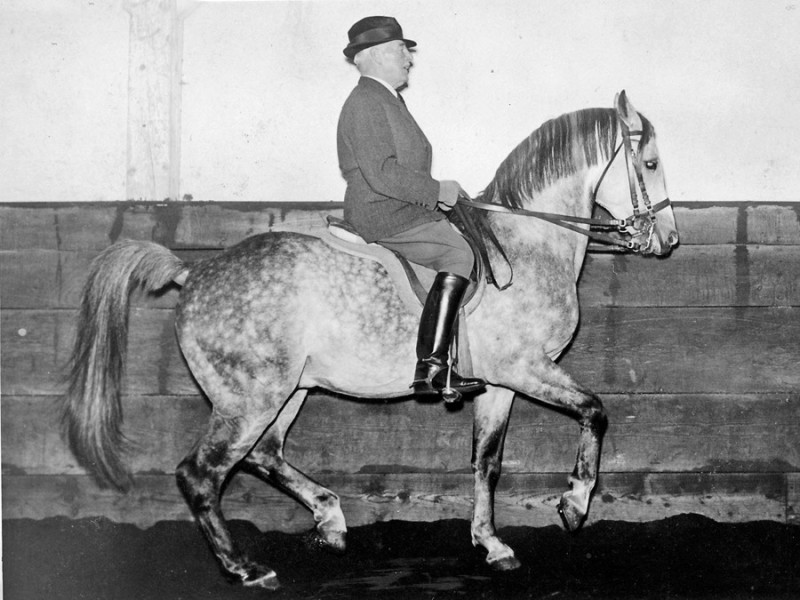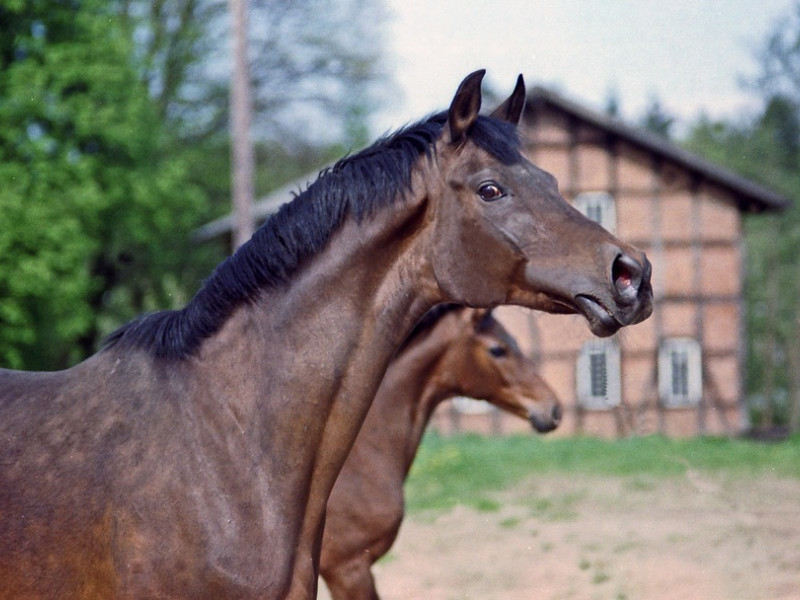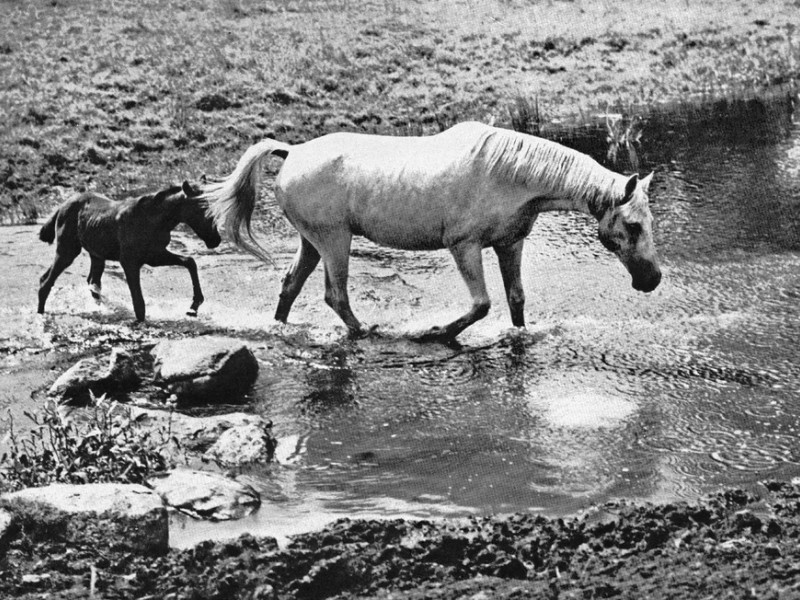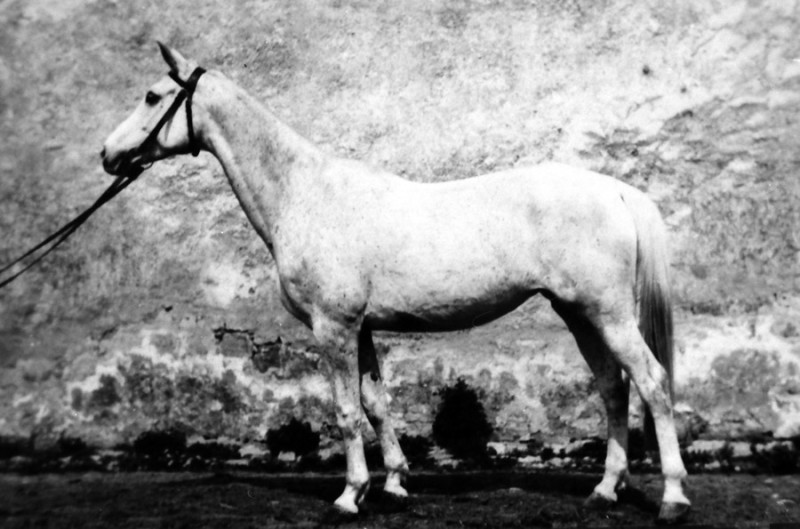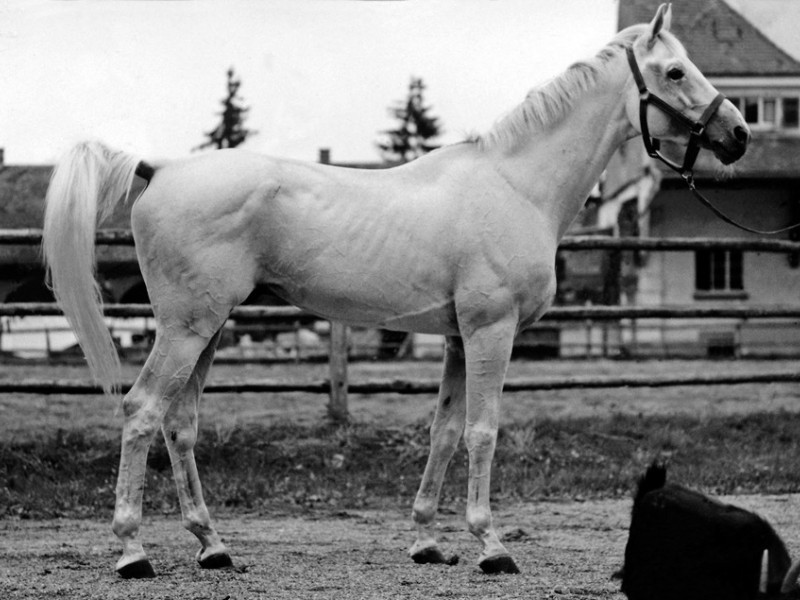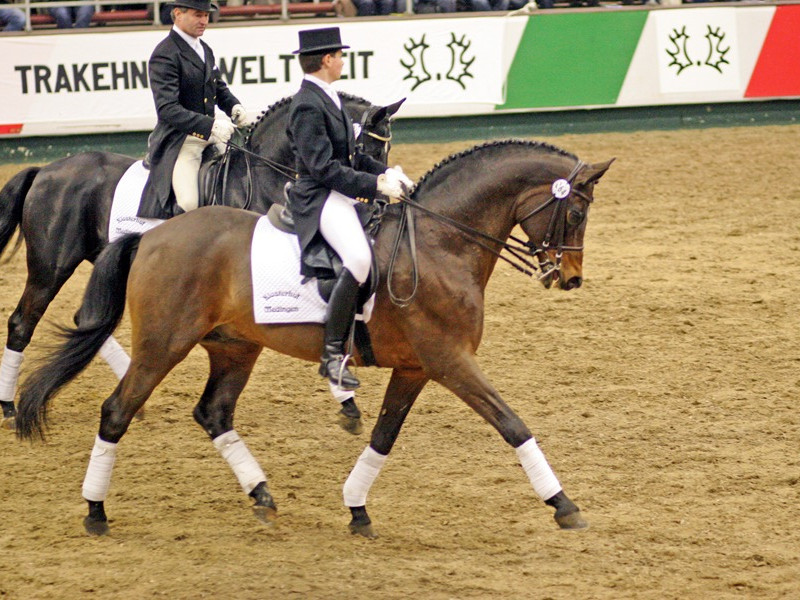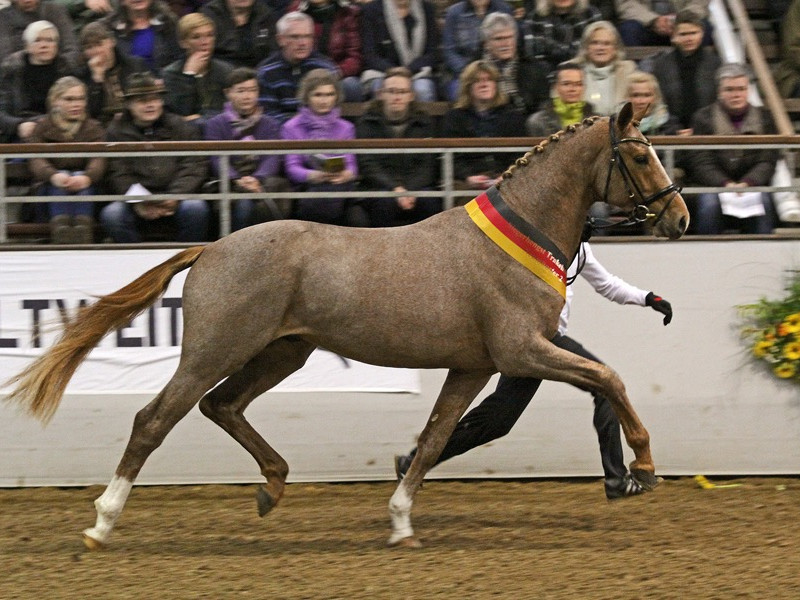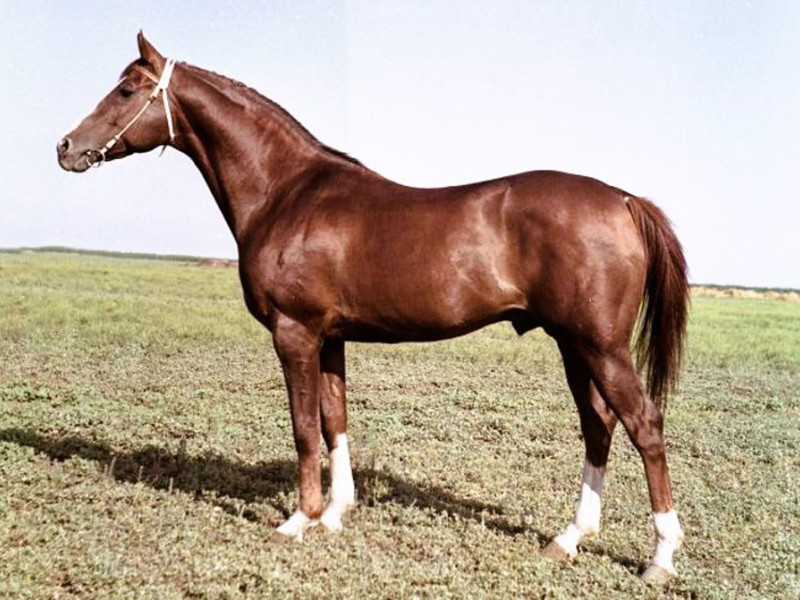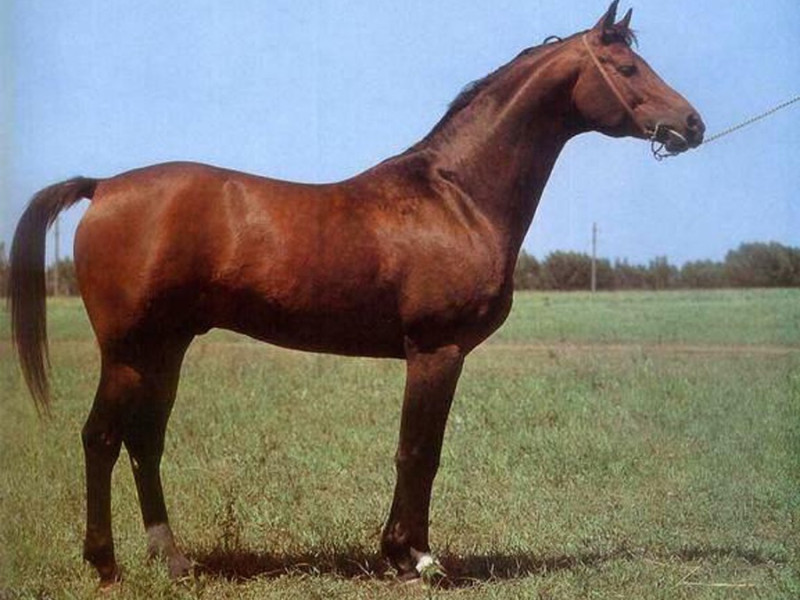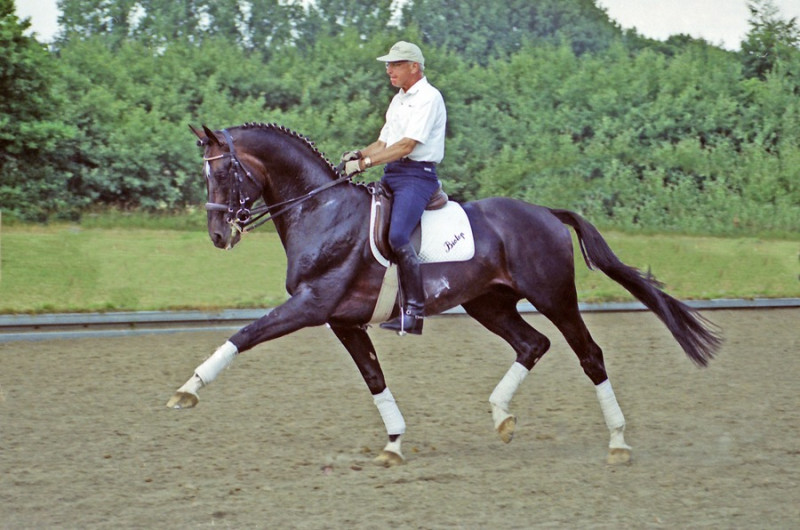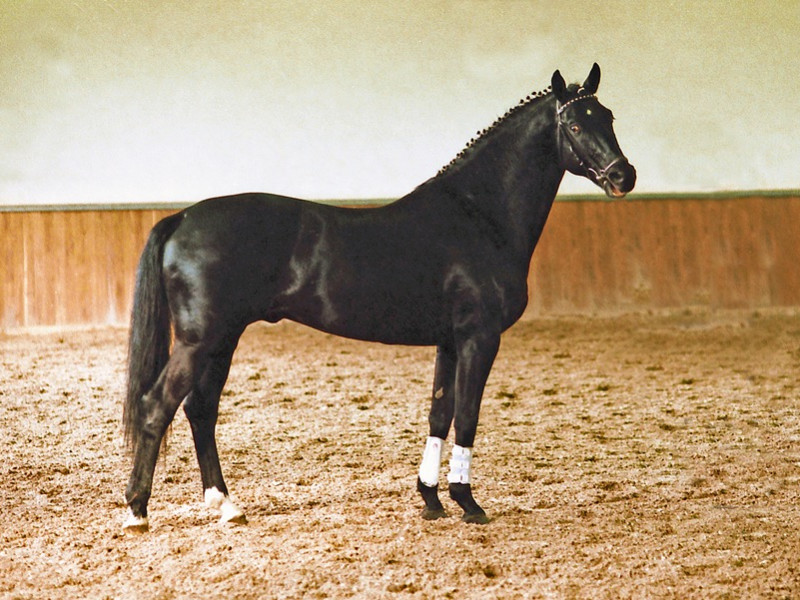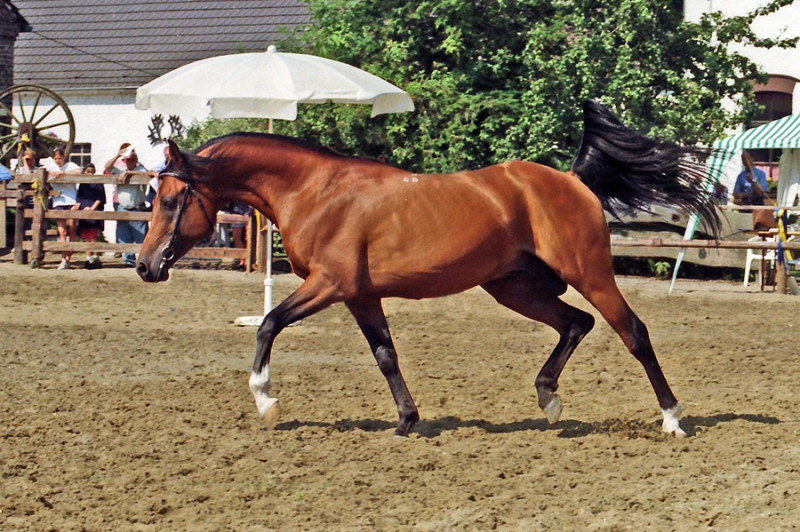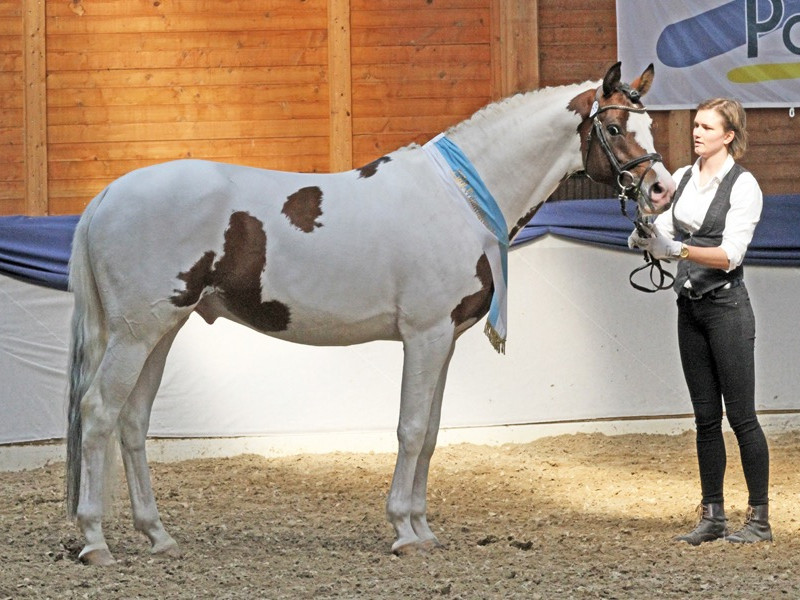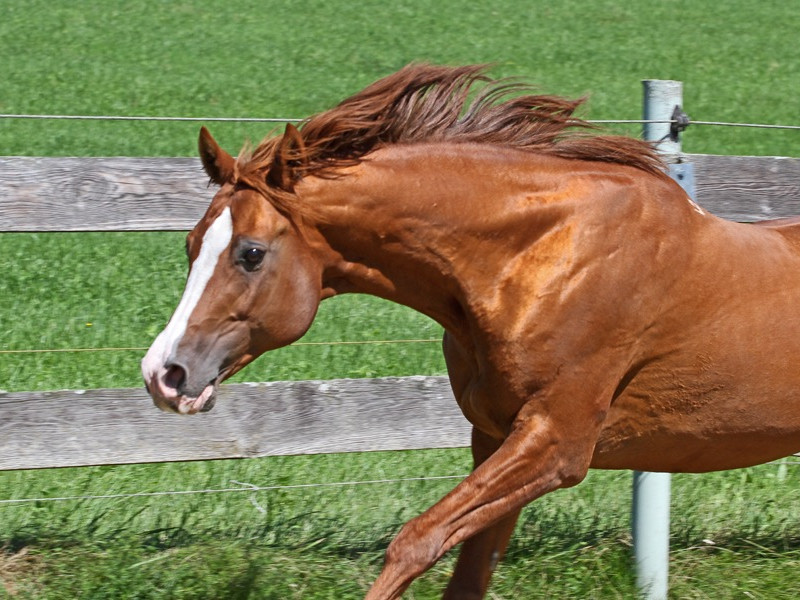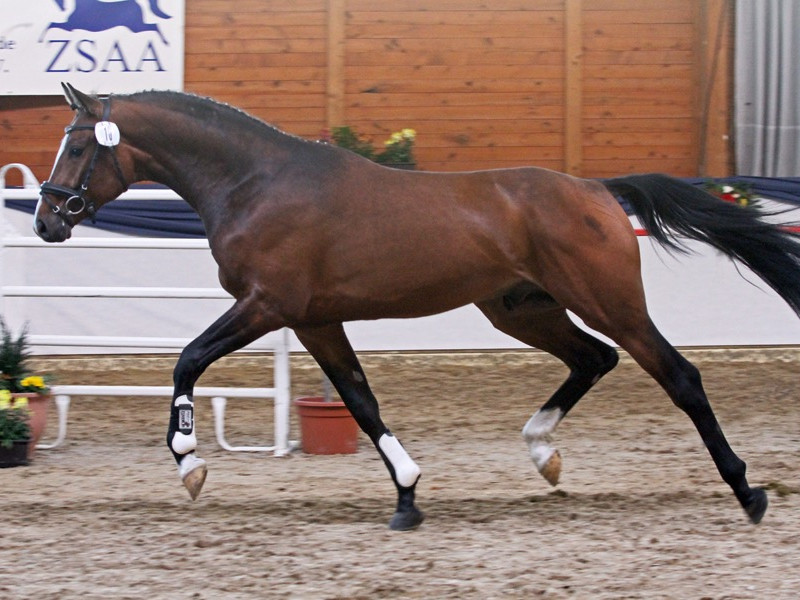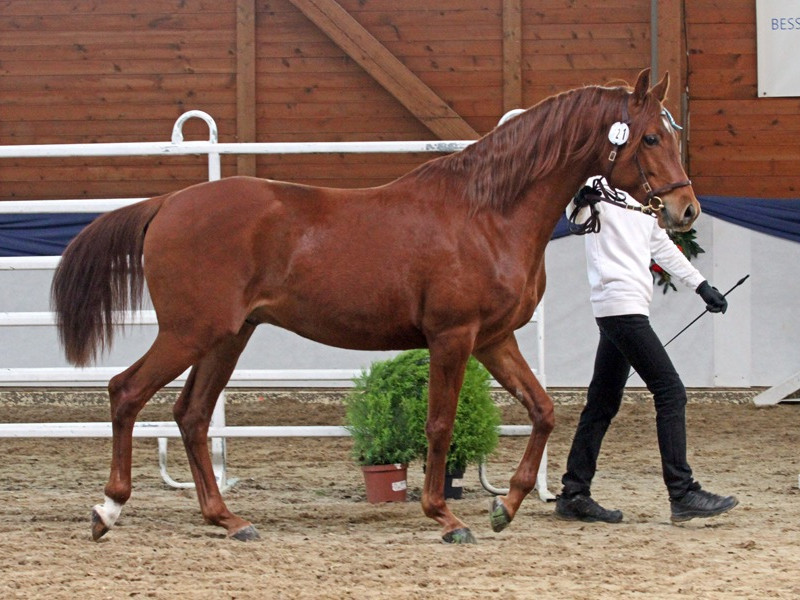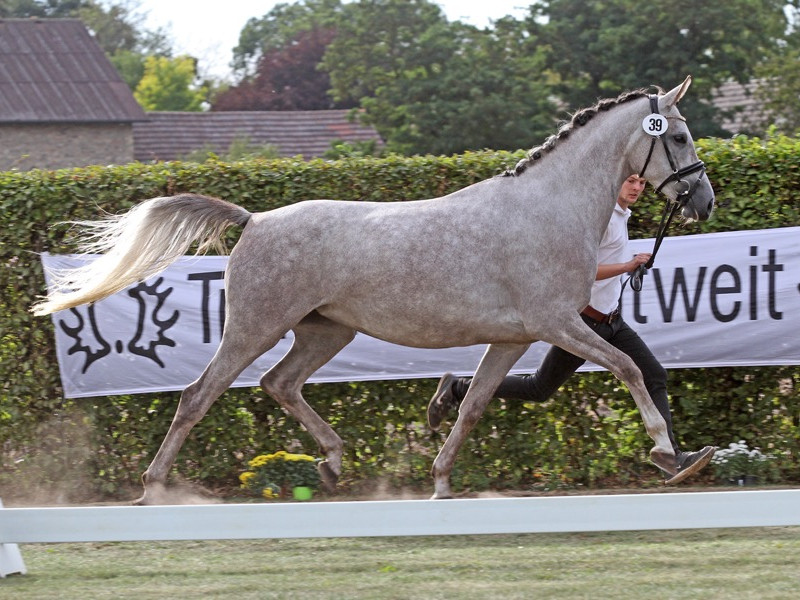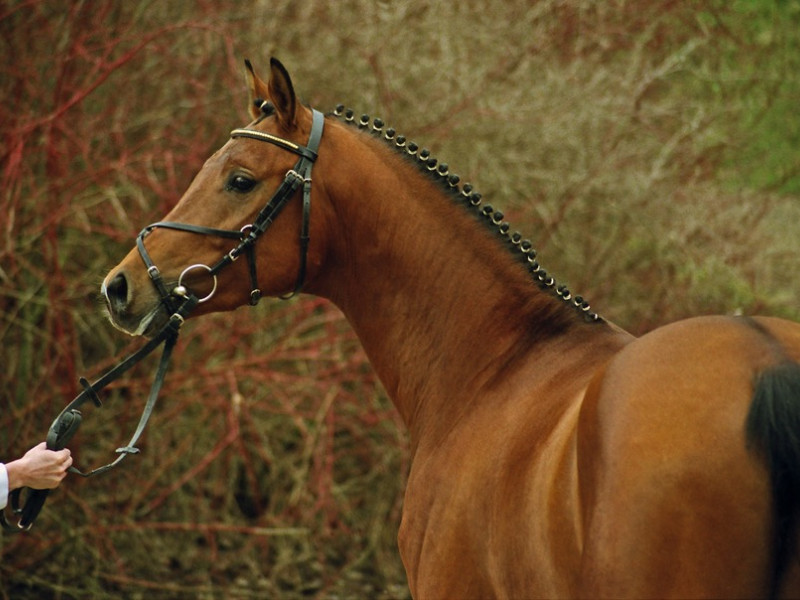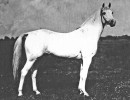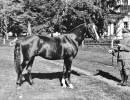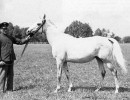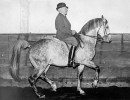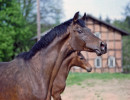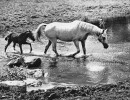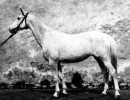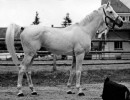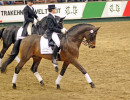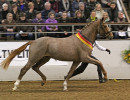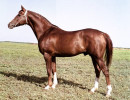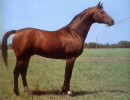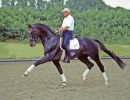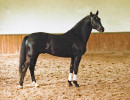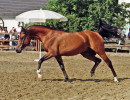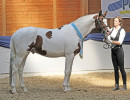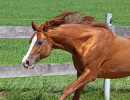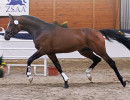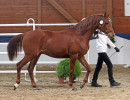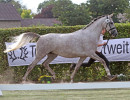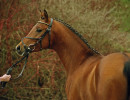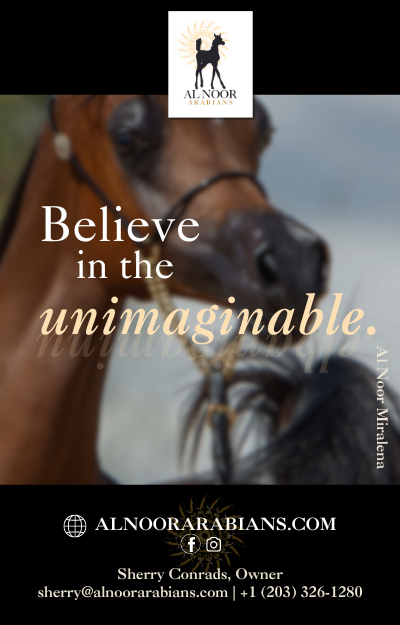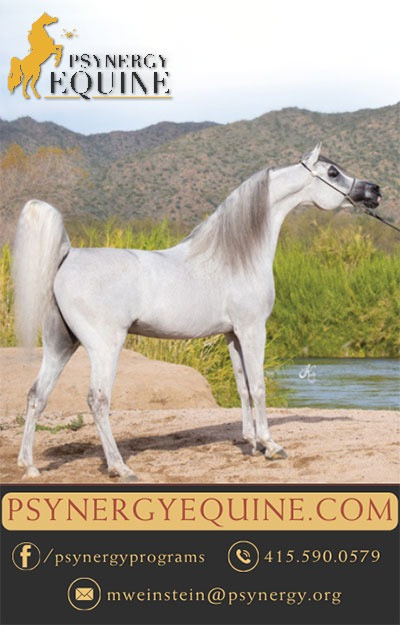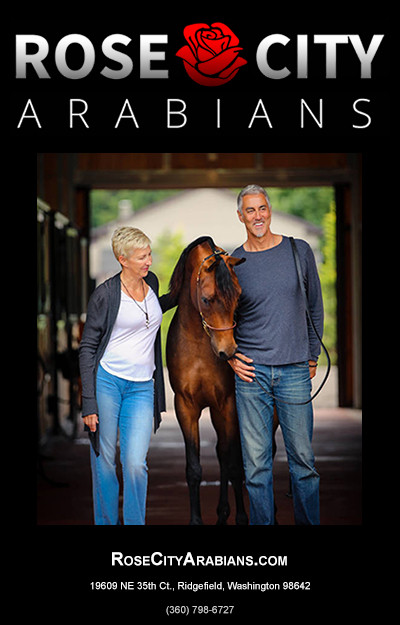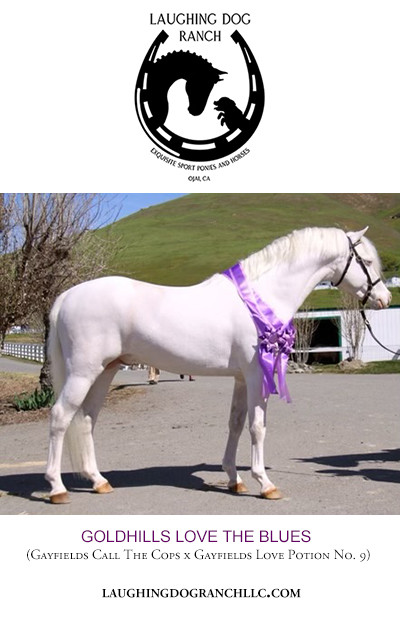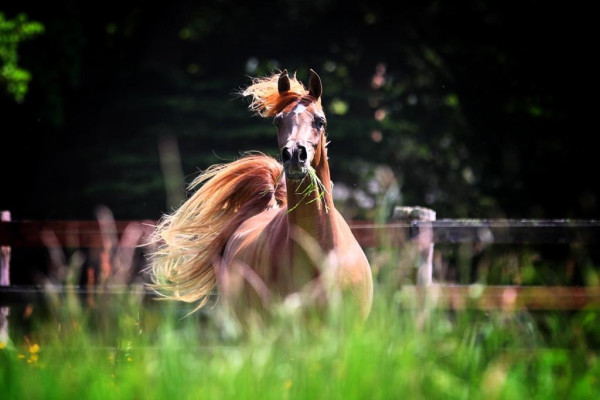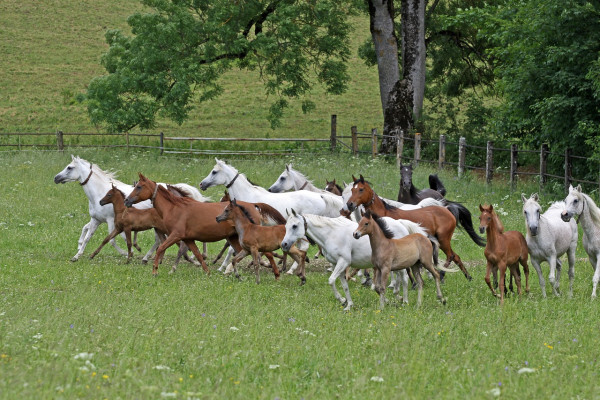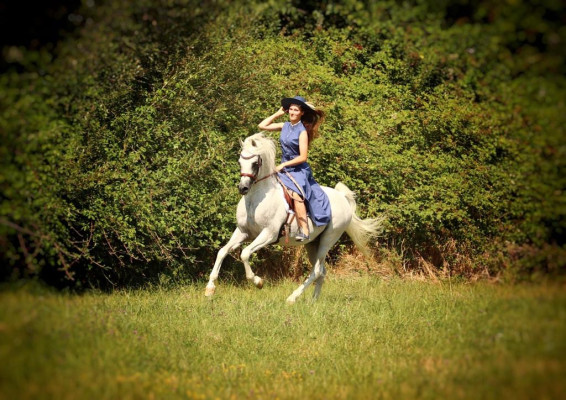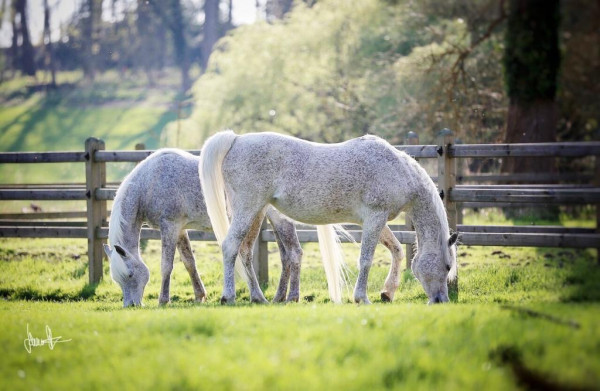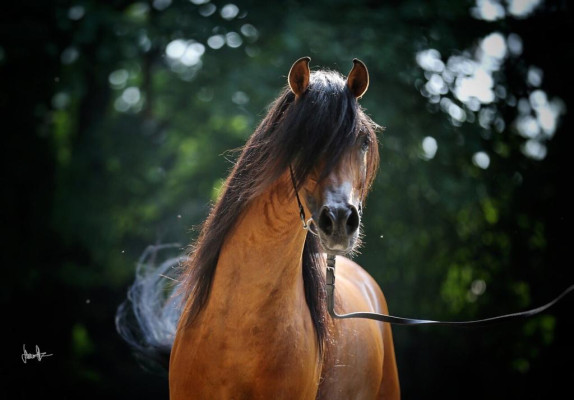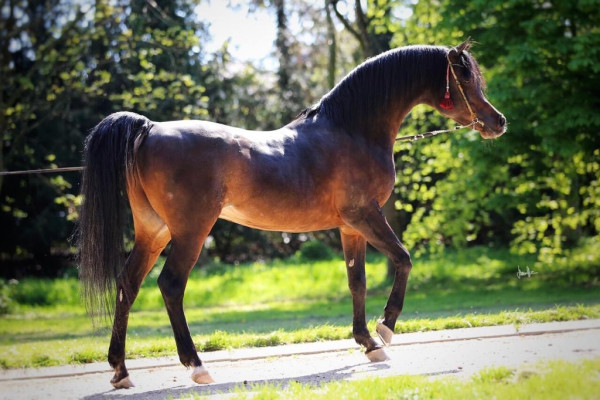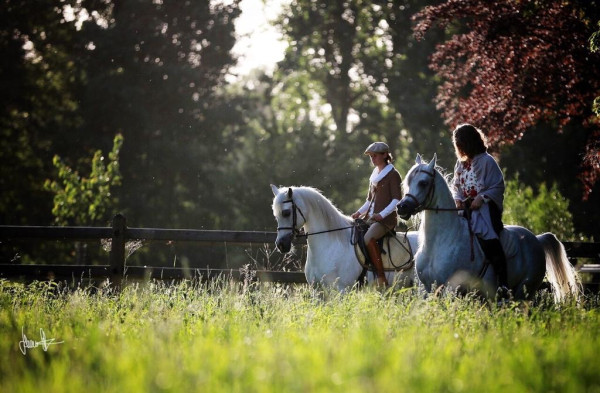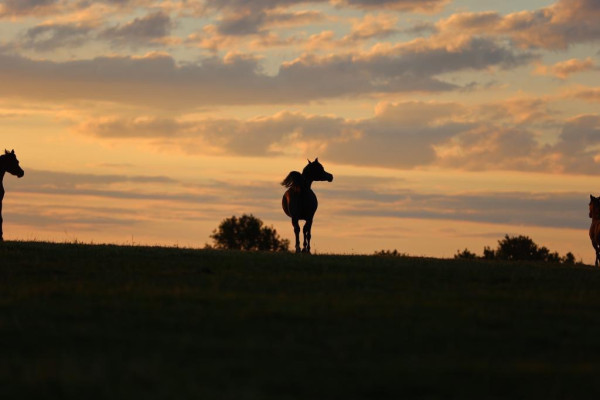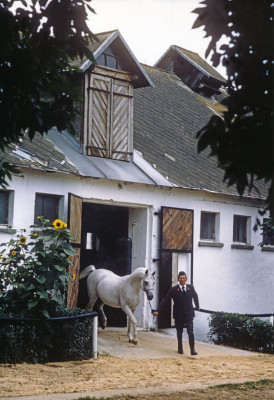Blood Ties: The Arabian—Trakehner Connection
by Betty Finke
Of all warmblood horses, the Trakehner has most in common with the Arabian. It is an old breed, with a long history and a rich background of tradition. Known for its beauty and refinement, its stamina, and its versatility, it is often used to strengthen those characteristics in other breeds. It is a former war horse turned sport horse and reliable partner for all equestrian pursuits. The parallels are no coincidence: of all light horse breeds, the Trakehner owes most to the Arabian.
The breed’s proper name is “East Prussian Warmblood of Trakehner Descent," which is a bit of mouthful, so it is usually referred to simply as “Trakehner.“ As the name implies, the breed originated in East Prussia, which was formerly the eastern-most region of Germany (since World War II, it’s been divided between Poland and Russia). Trakehnen itself was the East Prussian state stud, founded in 1732 by King Friedrich Wilhelm I.
When the Trakehnen Stud was founded in 1732…Riding horses longer had to carry knights in armour. Arabian horses, faster and more agile as well as more elegant … … were the obvious choice to cross with the local breeds…”
The native East Prussian horse breed, however, is much older than the stud to which it owes its name. No less than 31 stud farms were recorded in East Prussia during the 15th century, breeding heavy riding horses of the kind suitable for knights in armour. Similarly to neighbouring Poland, the local aristocrats all maintained their own breeding programs. One of the most notable was that of the Dohna family, which in the 17th century kept the first German stud book on record; over a century before the General Stud Book was established in Britain.
When the Trakehnen Stud was founded in 1732, horse breeding was changing. Riding horses were still needed mainly for the cavalry, but they no longer had to carry knights in armour. Arabian horses, faster and more agile as well as more elegant than the heavier European horses, were the obvious choice to cross with the local breeds to bring in the desired qualities. The first recorded chief sire at Trakehnen was a stallion named Persianer, who, given his name, “Persian” was clearly an Oriental horse, most likely an Arabian. Another celebrated 18th century sire, Turcmainatti, has variously been identified as an Arabian or a Turkmen horse. Given his name, Turkmen seems more likely, but his portrait shows a distinctly Arabian tail set and carriage. He ended up in the possession of Napoleon, whose partiality for Arabians is well known; as one of the 75,000 East Prussian horses lost during the Napoleonic wars.
By the late 19th century, East Prussian horses had gained the reputation of being the world’s best cavalry horses. Wilhelm Carl Friedrich von Burgsdorff, stud director of Trakehnen during the first half of the 19th century, used mostly Thoroughbred and Arabian sires, often desertbred imports. These included Nedjed, foaled in 1810, and Bagdadly, foaled in 1809. Neither of them left a sire line, but the mare Gyare, by Nedjed out of a Bagdadly daughter, founded an extensive mare family. Her dam line is still going strong today and includes many approved sires and champion mares.
The last and biggest influx of Arabian blood at Trakehnen happened during the 1930s, when the stud was at the height of its fame. One of its chief sires at the time was the Arabian stallion Fetysz (Bakszysz x 28 Siglavy Bagdady), a former chief sire at Janow Podlaski, imported from Poland; other Polish Arabian stallions at Trakehnen at the time were Lowelas (Koheilan I x Elegantka) and Adamas (Kohejl Ibn Mazepa x Arabella). In 1935, Trakehnen purchased four purebred mares from the Royal Weil Stud in Württemberg: Dongola (Jasir x Doris), Khasa (Dynamit x Carmen), Czeska (Jasir x Caesarea), and Glaukopis (Jasir x Carmen). The Egyptian import Jasir (Mabrouk Manial x Nigma), who sired three of them, was the last sire used at Weil before the herd was transferred to Marbach in 1932.
The sheer dimensions of the Trakehnen Stud are hard to grasp from today’s perspective. In the years leading up to WW II, Trakehnen maintained nine (!) separate herds of mares on different outlying estates. There was a black herd, a chestnut herd, and a bay herd. They were distinguished not only by color, but also by type, the blacks traditionally being heavier than the more elegant chestnuts. Then there was a mixed color herd, which included the greys. There was even an Arabian herd, made up of purebred and Half-Arabian mares as well as a few Thoroughbreds, including the four mares from Weil and a handful of mares imported from Poland. Among the Polish mares were Obra (Hardy x Ikwa) and her daughter Lagodna by Posejdon, who was captured by the Russians at the end of the War. They are well-known today as the dam and grandam of *Naborr, but few people are aware that there were broodmares at Trakehnen first who produced several daughters there!
“…right now there are more approved Trakehner stallions that are Half-Arabians than ever before.”
Another Polish mare at Trakehnen in the 1930s was Karima (Farys I x Rusalka), who also appears in Arabian pedigrees. At Trakehnen, she produced a purebred daughter by Fetysz named Khamza, who in turn produced the purebred stallion Kanzler by Lowelas. Kanzler was evacuated to West Germany and briefly stood at Marbach, the only Arabian stallion bred at Trakehnen to be used in pure Arabian breeding. His daughter Smoky was the dam of Sascha, who was exported to Australia and became very influential there through her son Amir El Shaklan during the 1980s.
Sadly, most of Trakehnen’s Arabian horses – as well as uncounted Trakehners – were lost during the final phase of the War. The flight of the East Prussian breeders and their horses from the advancing Russians has passed into legend as the one defining and iconic event in the history of the Trakehner breed. It has been called the ultimate endurance test. All Trakehner horses today, excepting those bred in Russia, are descended from the horses that survived that gruelling mid-winter trek, often carrying their owners and pulling wagons loaded with refugees, constantly harassed by bombers.
After the War, the East Prussian refugees tried to pick up the pieces, collect and register the surviving horses, and rebuild their breeding programs. This was easier said than done, because the West German breeders with their own Hanoverians, Holsteiners, and other regional warmblood breeds, were none too happy about the newcomers. Deliberate and enduring attempts were made to discredit the breed, claiming Trakehners were “difficult" and, though they had pretty heads, were not much use otherwise. Arguments that should sound very familiar to Arabian owners!
But the Trakehner eventually survived being uprooted, diminished, and regarded with suspicion. A few stallions found their way into other breeds and achieved great things, while others – many of them carrying irreplaceable bloodlines – never got a chance to leave their mark. A few large stud farms were eventually established, mainly in the north of Germany, where most of the evacuated horses had ended up, gathering substantial herds of rescued mares, including some from Trakehnen itself. One of these farms, Rantzau, produced its own strong family by breeding one of their best mares to the Marbach-bred Arabian stallion Marsuk (Haladin x Malacha). The filly resulting from that breeding, Scherezad, went on to establish one of the most successful dam lines in the breed today.
Trakehnen’s purebred Arabians were all lost in the War, although information has come to light suggesting that Fetysz himself might have survived (see sidebar). But several horses with a high percentage of Arabian blood made it to West Germany and became true cornerstones of the breed. The most notable among them, all with at least 50% Arabian blood:
Famulus, 1938 grey stallion by Fetysz
Kassette, 1937 grey mare by Harun Al Raschid (Arabian) and from the dam line of Gyare
Donna, 1939 grey mare by Cancara (Trak.) out of Dongola
Pelargonie, 1942 grey mare by Lowelas out of Perina by Fetysz
Elfe, 1940 grey mare by Adamas
Fetysz’s sire line survived against the odds, because Famulus sired only one son. This was the grey stallion Maharadscha who, though only 25 percent Arabian, clearly reflected his descent in type and colour. Foaled in 1957 out of Marke, an East Prussian mare who had survived the Trek, Maharadscha had a rocky start and very nearly didn’t make it to maturity. He looked poorly when he came up for approval and most likely would not have been approved if the circumstances had been different! It is fortunate that he was, because he went on to sire the hugely influential stallion Flaneur, whose sire line was one of the largest in the breed during the 1980s and 1990s. The most famous among them were Flaneur’s son Arogno, out of a Thoroughbred mare, and Arogno’s grandson Caprimond, one of the leading sires of the 1980s. Caprimond was a magnificent and stunningly beautiful stallion with a head that clearly showed the Arabian influence, and which he passed on faithfully. You could identify Caprimond’s get by their heads. Unless they were chestnut, that is; the type only came with the bays and the blacks, but they made up the vast majority of his get.
Wilhelm Carl Friedrich von Burgsdorff, stud director of Trakehnen during the first half of the 19th century, used mostly Thoroughbred and Arabian sires, often desertbred imports.
As for the mares, Kassette, Donna, Pelargonie, and Elfe all established important mare families that continue to go strong. All these horses were grey, including Maharadscha, so if you see a grey Trakehner, you can be pretty certain the color comes from one of them. A famous example is the Olympic show jumper Abdullah, who won many medals for the U.S. during the 1980s with his rider Conrad Homfeld. He was out of a Maharadscha daughter, Abiza.
Of the Trakehners that didn’t make it into West Germany, many were captured by the Russians and joined the Kirow Stud (or, in the case of Lagodna and other Arabians, Tersk). Kirow developed its very own Trakehner breeding program, using their own Arabians from Tersk. The Tersk chief sires Priboj, Pomeranets, and Topol all sired Trakehners at Kirow, frequently producing superior sports horses. The Half-Arabian Hockey, sired by Pomeranets, is often considered the best stallion bred at Kirow. During the final decade of the 20th century, German breeders discovered these horses and imported several of them, including the top level show jumper Almox Prints J and the dressage horses Biotop and Perechlest. Almox Prints and Perechlest were Hockey sons, while Biotop was out of a Hockey daughter. In addition to adding new Arabian blood, these stallions also brought back old Trakehner lines that might have vanished otherwise. Hockey himself was imported to Denmark as an old horse and had a second breeding career in the West.
A second Arabian sire line was established after the War by the Anglo-Arabian stallion Burnus. Foaled in 1948, Burnus was sired by the Shagya-Arabian Lapis. Lapis in turn was descended in tail male line from the desertbred Siglavy, the only stallion to establish sire lines in three breeds: the Shagya-Arabian, the Lipizzaner, and the Trakehner. While the sire line no longer exists in purebred Arabians, Siglavy’s blood made it into the breed through his famous grandson Amurath 1829, one of the most significant sires at Weil, who was out of a Siglavy daughter.
The Lapis-Burnus line established itself through the Burnus son Habicht, who was an impressive stallion, but not very Arabian-looking. The strongest branch is that of the Habicht son Sixtus, a beautiful black stallion who lived well into his thirties and was one of the breed’s most influential sires. Another of Habicht's best sons, Windfall, was imported to the USA. As of today, this line is now the prevalent Arabian sire line in the Trakehner breed, with Fetysz – once one of the two strongest lines – having fallen behind.
This shift reflects the changing policy of the Trakehner Society towards the millennium. The horses of the Fetysz line were great dressage horses, while those of the Lapis-Burnus line excelled as eventers and show jumpers, and the Society strongly promoted jumping ability and placed an emphasis on this when selecting breeding horses. It is safe to say that during the past few decades, the Trakehner breeders fell into the exact opposite trap to the one that caught the Arabian breeders: While Arabian breeders are now putting type above all else, choosing extreme heads over functional conformation, Trakehner breeders began to neglect type in favor of athletic ability – a policy that resulted in excellent sports horses that no longer look different from any other sports horse breeds. Where in the past you could easily pick out a Trakehner in a crowd by its head alone, you now had to look at the brand to identify the breed.
Not everyone cared for this development, and some breeders chose to use the obvious counter-measure: introduce new Arabian blood. But these were just sporadic infusions done by small breeders. While there was no lack of approved Arabian stallions, few breeders used them. The only one who went for it in a big way was Gottfried Hoogen, many years president of the Trakehner Society and the man who had bred Maharadscha. In the 1990s, he acquired the purebred Russian stallion Kosmonaut (Naftalin x Karinka) and bred all his mares to him. Since he was an influential man, all his clients followed suit and bred their mares to Kosmonaut, and for a while it looked like an Arabian renaissance was on its way. Several of Kosmonaut’s daughters achieved premium status, one of them produced an approved stallion. Some breeders took heart and used other Russian stallions, like Drug and Normativ. But for some reason, it all fizzled out again. It has to be said that the breeding director at the time didn’t really know what to make of those Half-Arabian foals, and his lukewarm commentaries – never failing to point out lack of size – may have done a lot of damage.
Not surprisingly, many Trakehner breeders who used Arabian stallions chose to join the Breeding Society for Arabian Sports Horses instead, registering their horses as partbred Arabians rather than Trakehners.
In recent years, though, there has been an upswing, and right now there are more approved Trakehner stallions that are Half-Arabians than ever before. The first of the current lot was Gabun (Camaro x Galina), who is out of a straight Russian Arabian mare. This striking stallion is not only Half-Arabian, but also a pinto (an old Trakehner tradition that was nearly lost) and the last representative of one of the original old Trakehner sire lines. He has already sired three approved sons, though not all of them are Trakehners. There are now three approved Trakehner stallions sired by the Russian Arabian Pagur (Gepard x Pospa), and one sired by the U.S.-bred Zonyx (Enzo x Balih’s Treasure), a successful dressage horse. In December 2023, two Half-Arabian stallions were presented for approval, and both were approved – something that has never happened before. Two daughters of the late chief sire of Marbach, Dschehim (Pamir I x Dschihan) have been registered as broodmares with premium status. One of them has already produced premium foals of her own; the other is currently in foal to Pagur for a three-quarter Arabian/Trakehner foal.
Dschehim’s son and successor at Marbach, WM Devdas, is also getting some interest from Trakehner breeders. The fact that he stands a full 16 hands tall may put off Arabian breeders, but for Trakehners his size is an asset. As a bonus, he is also a talented show jumper.

Click here to see a related story also by Betty Finke: The Mystery of General Patton’s White Stallion.
As Betty says, "This is, in fact, an exclusive, as far as Arabian publications are concerned, because it hasn't been published anywhere before. I discovered it quite by chance, hidden away in this enormous supplement to the Trakehner stud book along with other fascinating stuff."
Fetysz (Bakszysz x 28 Siglavy Bagdady), fomer chief sire at Janow Podlaski and the single most influential Arabian sire in Trakehner breeding. Lowelas (Koheilan I x Elegantka), one of several Polish Arabian stallions standing at Trakehnen in the 1930s. Sire of foundation mare Pelargonie. Dongola (Jasir x Doris), 1932 Arabian mare bred at Weil and sold to Trakehnen. Dam of foundation mare Donna. Kanzler (Lowelas x Khamza by Fetysz), 1942 purebred Arabian stallion bred at Trakehnen, still found in Arabian pedigrees today. Scherezad, 1968 Half-Arabian Trakehner mare by Marsuk (Haladin x Malacha), founder of a significant dam line. Kassette, 1937 Half-Arabian Trakehner mare by Harun Al Raschid from the dam line of Gyare by Nedjed db, post-war foundation mare. Donna (Cancara x Dongola), 1939 Half-Arabian Trakehner mare, founder of the "D" family. Maharadscha (Famulus x Marke), 25% Arabian/Trakehner stallion, the Fetysz grandson who established his line after World War II. Caprimond (Karon x Capri VI), 1985 Trakehner Elite stallion, chief progenitor of the Fetysz sire line. Donauruf (Herzruf x Dolce Vita III), 2010 Trakehner stallion from the dam line of Donna-Dongola (Murana I db). Pomeranets (Priboj x Mammona), along with his sire Priboj and half-brother Topol (x Taktika), was one of the Arabian stallions heavily used in Russian Trakehner breeding. Hockey, 1973 Half-Arabian/Trakehner stallion by Pomeranets (Priboj x Mammona) bred by Kirow Stud, Russia. Biotop (Blesk x Plaksa by Hockey), 1985 Russian Trakehner stallion and international dressage champion with Dr. Reiner Klimke. Sixtus (Habicht x Stradelle), 1989 Trakehner stallion, chief progenitor of the Siglavy db-Lapis sire line. Kosmonaut (Naftalin x Karinka), 1986 Russian Arabian stallion who initiated a brief Arabian renaissance among Trakehner breeders during the 1990s. Gabun, 2011 Half-Arabian Trakehner stallion by Camaro out of the straight Russian Arabian mare Galina II (Vatican x Gurba). Pagur (Gepard x Pospa), 2007 purebred Russian Arabian stallion with three approved Trakehner sons. Podarok, 2019 Half-Arabian/ Trakehner stallion by the Russian stallion Pagur (Gepard x Pospa). Bacardi, 2018 Half-Arabian/Trakehner stallion sired by the U.S.-bred dressage Arabian Zonyx (Enzo x Balihs Treasure). Santa Arabica, 2015 Half-Arabian Trakehner mare by Dschehim (Pamir I x Dschihan). Brioni, 2001 Half-Arabian Trakehner stallion by Friedensfürst out of the straight Russian Arabian mare Bagheerah (Bagdad x Adyca)